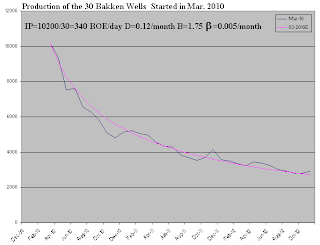How Much Natural Gas Reserve Do We Have
There's been a propaganda that the world has a reserve of hundreds of years worth of supply of natural gas, in the form of shale gas. Nothing could be further from the truth, as natural gas is the least abundant of all three fossil fuels: coal, petroleum and natural gas.
But exactly how much natural gas reserve the world has? And how much the USA has within its land?
One thing can give us some clue, the oxygen in the earth's atmosphere,which can be calculated accurately.
Oxygen does not exist without life form. Every free oxygen molecule that exists in the atmosphere was breathed out by an ancient life form, which uses the photo synthesize or other energy driven process to extract the oxygen either from carbon dioxide, or from water. So each and every oxygen molecule is associated with some alive or dead biomass on earth, or with some carbon scattered in the soil which originally came from biomass, or with buried fossil fuels. So let's do some calculation.
The entire atmosphere of the earth, if condensed into a layer of uniform pressure of one standard atmospheric pressure, 101325 pascal, then it will be a layer of 26200 feet (8000 meters) thick.
Oxygen is 20% of the atmosphere, in volume. So the atmospheric oxygen can be condensed into a uniform layer of 5240 feet deep on the earth surface. That gives us an idea of the quantity.
Natural gas is mostly methane molecules, which contains one carbon and four hydrogen atoms. When one carbon atom is extracted from CO2 (carbon dioxide), two oxygen atoms are released. When four hydrogen atoms are extracted from water molecules, H2O, two oxygen atoms are released. So one methane molecule is associated with four oxygen atom, or two oxygen molecules. That's a 1:2 ratio.
Thus, if the earth's 5240 feet thick layer of oxygen is completely associated with buried natural gas, and there is no other biomass or fossil fuel. That will give us a uniform layer of 5240/2=2620 feet of buried natural gas. That's the absolute theoretical maximum, assuming there is no live organs, no scattered biomass and no other fossil fuels, just buried natural gas only.
But we know the distribution of biomass and fossil fuels are not uniform. The ocean is four times as active as the land area as a biomass circle. Consider 29% of the earth surface is land and 79% is ocean, the layer of biomass on land is only 32% (100%/(29%+4*71%) = 32%) of the global average. That's equivalent to a layer of 838 feet deep, if all the land biomass is converted to underground natural gas reserve.
But not all biomass is converted to natural gas! Some of them are living organisms: animals, plants, insects, germs, etc. Some of them are scattered biomass int he soil. Only a small portion is converted to fossil fuel.
Based on best available scientific estimates, vast majority of biomass either exists in live organisms, or in organic material scattered in soil. Only a small portion, less than 10%, forms ancient fossil fuels. So that cuts possible fossil fuel down to the equivalence of a 84 feet deep natural gas layer.
But NOT all fossil fuels exist in the form of natural gas. Vast majority of buried ancient biomass becomes just carbon when they were compressed at high temperature and high pressure underground and dehydrated. That forms coal. A small portion, given existence of water and micro-organism and suitable conditions, can be converted into hydrocarbon by combining with hydrogen extracted from water by such germs. My estimate is 70% of fossil fuels became coal, and 30% became various hydrocarbon. Within the 30% hydrocarbon fossil fuels formed, 30% became the thicker and heavier hydrocarbon molecules, which is petroleum, and only 10% became the lightest hydrocarbon, methane, or CH4. So 10% of the 84 feet worth of natural gas equivalent layer will be actual natural gas reserves. That gives us 8.4 feet.
The 8.4 feet deep is the average expected natural gas reserve you can find any where in land areas of the earth. How much is that for the USA? The USA has a land area of 9.3 million square kilometers, or 9.3 trillion square meters, or 328 trillion square feet. Multiply by 8.4 feet, the total expected buried natural gas reserve in the USA is 2760 trillion cubic feet of natural gas, or 2800 TCF (trillion cubic feet).
The USA extracts 28 TCF ofnatural gas per year. So 2800 TCF of underground natural gas can provide 100 years of supply. But that's assuming every single buried natural gas molecule can be extracted. That is of course unrealistic. Most of buries natural gas molecules are either not concentrated enough to be extracted economically, or can not be extracted completely due to technology limitation.
Take shale gas as an example. Geologists estimate that by hydraulic fracturing, only no more than 5% of the original gas in place can be extracted and produced. The other 95% stays underground.
So that cuts producible natural gas to 5% of 2800 TCF, or 140 TCF, or a mere 5 years supply of shale gas.
The USA does NOT have one hundred years of supply of shale gas. We have much less, five years worth, or maybe a little bit more. Not no where near one hundred year's worth of gas supply!



























